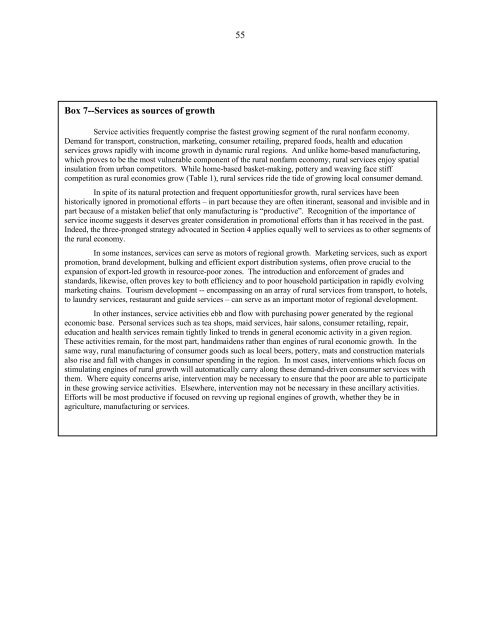Strategies for Stimulating Poverty-alleviating Growth in the Rural ...
Strategies for Stimulating Poverty-alleviating Growth in the Rural ...
Strategies for Stimulating Poverty-alleviating Growth in the Rural ...
You also want an ePaper? Increase the reach of your titles
YUMPU automatically turns print PDFs into web optimized ePapers that Google loves.
55<br />
Box 7--Services as sources of growth<br />
Service activities frequently comprise <strong>the</strong> fastest grow<strong>in</strong>g segment of <strong>the</strong> rural nonfarm economy.<br />
Demand <strong>for</strong> transport, construction, market<strong>in</strong>g, consumer retail<strong>in</strong>g, prepared foods, health and education<br />
services grows rapidly with <strong>in</strong>come growth <strong>in</strong> dynamic rural regions. And unlike home-based manufactur<strong>in</strong>g,<br />
which proves to be <strong>the</strong> most vulnerable component of <strong>the</strong> rural nonfarm economy, rural services enjoy spatial<br />
<strong>in</strong>sulation from urban competitors. While home-based basket-mak<strong>in</strong>g, pottery and weav<strong>in</strong>g face stiff<br />
competition as rural economies grow (Table 1), rural services ride <strong>the</strong> tide of grow<strong>in</strong>g local consumer demand.<br />
In spite of its natural protection and frequent opportunities<strong>for</strong> growth, rural services have been<br />
historically ignored <strong>in</strong> promotional ef<strong>for</strong>ts – <strong>in</strong> part because <strong>the</strong>y are often it<strong>in</strong>erant, seasonal and <strong>in</strong>visible and <strong>in</strong><br />
part because of a mistaken belief that only manufactur<strong>in</strong>g is “productive”. Recognition of <strong>the</strong> importance of<br />
service <strong>in</strong>come suggests it deserves greater consideration <strong>in</strong> promotional ef<strong>for</strong>ts than it has received <strong>in</strong> <strong>the</strong> past.<br />
Indeed, <strong>the</strong> three-pronged strategy advocated <strong>in</strong> Section 4 applies equally well to services as to o<strong>the</strong>r segments of<br />
<strong>the</strong> rural economy.<br />
In some <strong>in</strong>stances, services can serve as motors of regional growth. Market<strong>in</strong>g services, such as export<br />
promotion, brand development, bulk<strong>in</strong>g and efficient export distribution systems, often prove crucial to <strong>the</strong><br />
expansion of export-led growth <strong>in</strong> resource-poor zones. The <strong>in</strong>troduction and en<strong>for</strong>cement of grades and<br />
standards, likewise, often proves key to both efficiency and to poor household participation <strong>in</strong> rapidly evolv<strong>in</strong>g<br />
market<strong>in</strong>g cha<strong>in</strong>s. Tourism development -- encompass<strong>in</strong>g on an array of rural services from transport, to hotels,<br />
to laundry services, restaurant and guide services – can serve as an important motor of regional development.<br />
In o<strong>the</strong>r <strong>in</strong>stances, service activities ebb and flow with purchas<strong>in</strong>g power generated by <strong>the</strong> regional<br />
economic base. Personal services such as tea shops, maid services, hair salons, consumer retail<strong>in</strong>g, repair,<br />
education and health services rema<strong>in</strong> tightly l<strong>in</strong>ked to trends <strong>in</strong> general economic activity <strong>in</strong> a given region.<br />
These activities rema<strong>in</strong>, <strong>for</strong> <strong>the</strong> most part, handmaidens ra<strong>the</strong>r than eng<strong>in</strong>es of rural economic growth. In <strong>the</strong><br />
same way, rural manufactur<strong>in</strong>g of consumer goods such as local beers, pottery, mats and construction materials<br />
also rise and fall with changes <strong>in</strong> consumer spend<strong>in</strong>g <strong>in</strong> <strong>the</strong> region. In most cases, <strong>in</strong>terventions which focus on<br />
stimulat<strong>in</strong>g eng<strong>in</strong>es of rural growth will automatically carry along <strong>the</strong>se demand-driven consumer services with<br />
<strong>the</strong>m. Where equity concerns arise, <strong>in</strong>tervention may be necessary to ensure that <strong>the</strong> poor are able to participate<br />
<strong>in</strong> <strong>the</strong>se grow<strong>in</strong>g service activities. Elsewhere, <strong>in</strong>tervention may not be necessary <strong>in</strong> <strong>the</strong>se ancillary activities.<br />
Ef<strong>for</strong>ts will be most productive if focused on revv<strong>in</strong>g up regional eng<strong>in</strong>es of growth, whe<strong>the</strong>r <strong>the</strong>y be <strong>in</strong><br />
agriculture, manufactur<strong>in</strong>g or services.
















